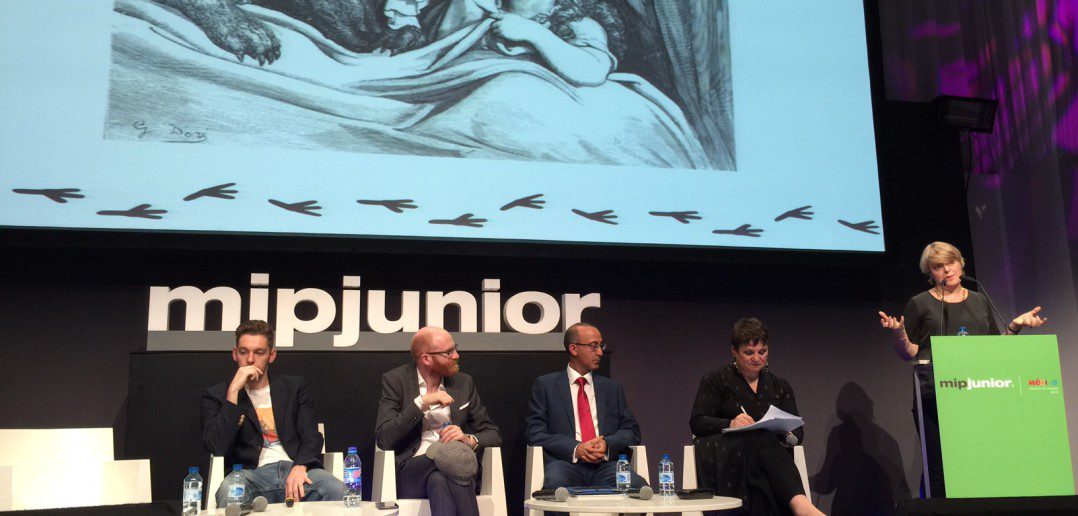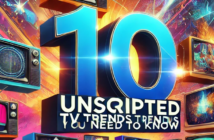The book publishing and TV production industries are no strangers to one another, with a long history of popular children’s shows having started their lives as books. Today at MIPJunior, a panel organised by The London Book Fair explored the latest examples of collaborations between the book and TV worlds, including new digital opportunities.
The panel comprised (left to right) Richard Haines, acquisitions and new business manager for Penguin Children’s at Penguin Random House; Paul Young, CEO of Cartoon Saloon; Asif Bashir, CEO, Unique Inspiration; Jacks Thomas, director of The London Book Fair (moderator); and Kate Wilson, managing director of Nosy Crow.
Bashir was first to speak, talking about taking characters Aku & Kamu from books to screen, with an animated series debuting at MIPJunior this year. Unique Inspiration worked with production company Starstruck Media, animation studio Medunecer and children’s TV director and writer Adrian Hedley on the project. « We believe the future is all about cross-media and cross-platform, » he said. « When we’re developing a brand, it’s all about 360: whether you can look at books, merchandising, TV productions. That’s what we need to do. »
Over to Young, who talked about Cartoon Saloon’s projects, from Oscar-nominated film The Secret of Kells to its new movie Song of the Sea, as well as TV show Skunk Fu and a new brand called Puffin Rock. It’ll be a 39-episode series of five-minute episodes, although the project has been going since 2008. In 2011, the company self-published books and an app, with Penguin, RTE Jr and Nick Jr signing up as partners since then. Production on the TV show began in October 2013, and it’s being shown off at MIPJunior this year.
Haines talked about Penguin’s side of this partnership, and how the company sees its role evolving. « We try to think of ourselves as the first new kind of publisher, » he said. This started with Penguin’s work on the new Peter Rabbit animated TV show, and has since included The Snowman and the Snowdog with Channel 4, and live-action pre-school drama Topsy and Tim – all based on Penguin’s book properties.
Now Puffin Rock: « Just being the publishing partner would be fantastic, but what if we could be bigger than that? » said Haines, saying it’s more than a book going to TV or vice versa. « This is really unique: the first time I’m aware of that they’ve been developed together, to live as a book and a TV show, and in lots of other areas. »
Over to Kate Wilson of Nosy Crow, the London-based publisher that releases picture books and apps. It launched in 2010 and began publishing in 2011 with a mixture of staff with backgrounds in publishing and games development. It has published 130 books and 14 apps so far.
« It’s amazing to think about every product being transmedia and cross-media. That’s not been my experience, » she said. « Some things work really really well as books, and they don’t translate to other media. » And she also talked about Nosy Crow’s learnings from launching apps, saying that kids have really high expectations from multimedia and interactivity, and that storybook-apps are competing with everything else on the app stores that children might use, games included.
Wilson also talked about the challenges that Nosy Crow has faced in making its apps: grappling with animation, recording voice narration and the process of actually developing the apps: coding.
Moderator Thomas asked Haines how much he has learned from working on a TV project right from the start. He said one big difference to traditional publishing is having to think about so many stories at once: a series worth, rather than a single story for a single book. « The worlds are not as different as people say they are though, » he added. « The content has to be incredibly strong, and great stories have to flow through everything. »
Wilson was asked how she decides whether a story should be a book or an app. She said that she takes a decision on each individual idea, while repeating her view that not every story will necessarily work as an app. She also noted that because of the initial development costs, making an app is higher-risk.
« We can risk so much more book publishing than we could ever risk in app publishing, and certainly in TV development, » she said, before adding that once an app has paid off its development costs, it becomes a very high-margin product for Nosy Crow.
Who’s the boss in development of TV and book projects? Young said that the original creator – the writer and/or director – should be the boss, but « a boss who can listen » to the feedback and ideas of partners. « You have to have a very strong creator, and then see where that takes you, » he said. Bashir talked about creative control: his company had it over the Aku & Kamu books, but said he listened lots to his partners for the TV aspects. Trusting collaboration was key – a suggestion that brought enthusiastic nods from his fellow panelists.




